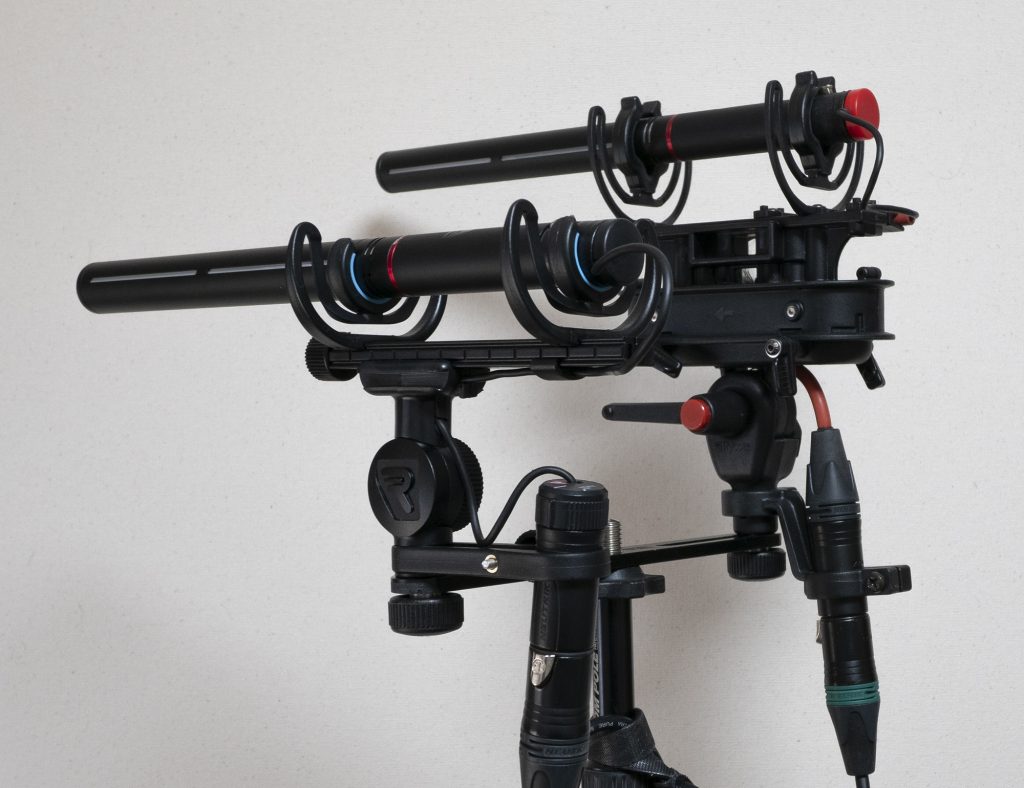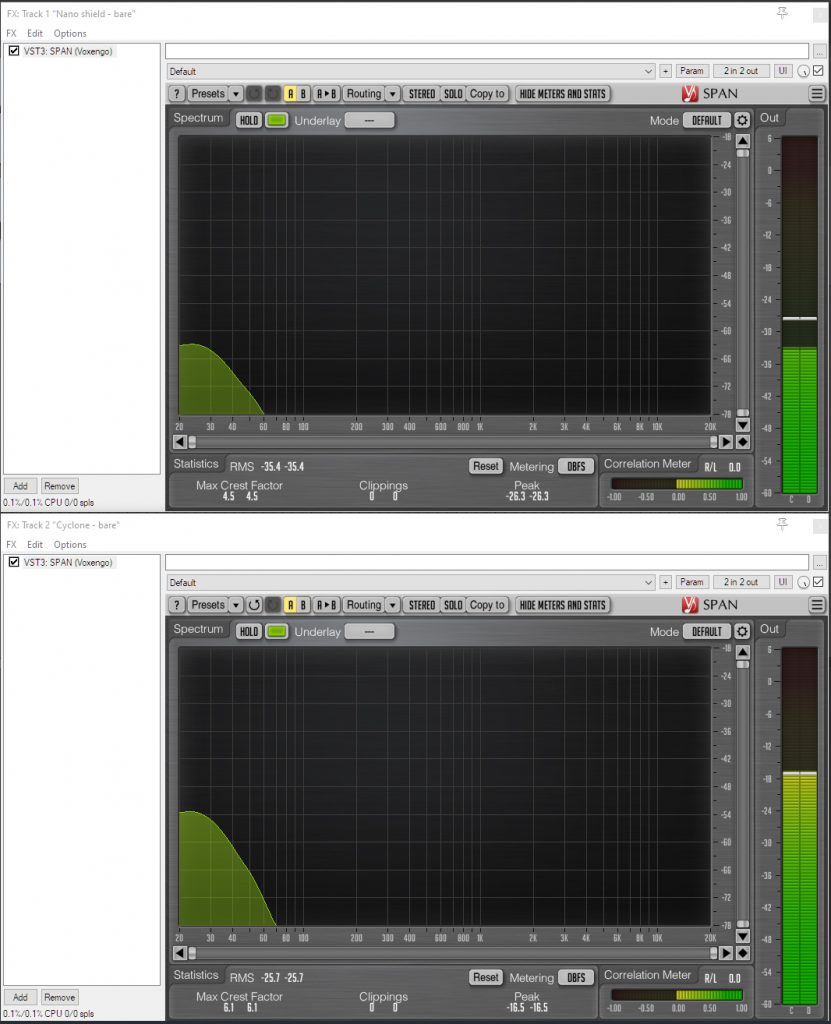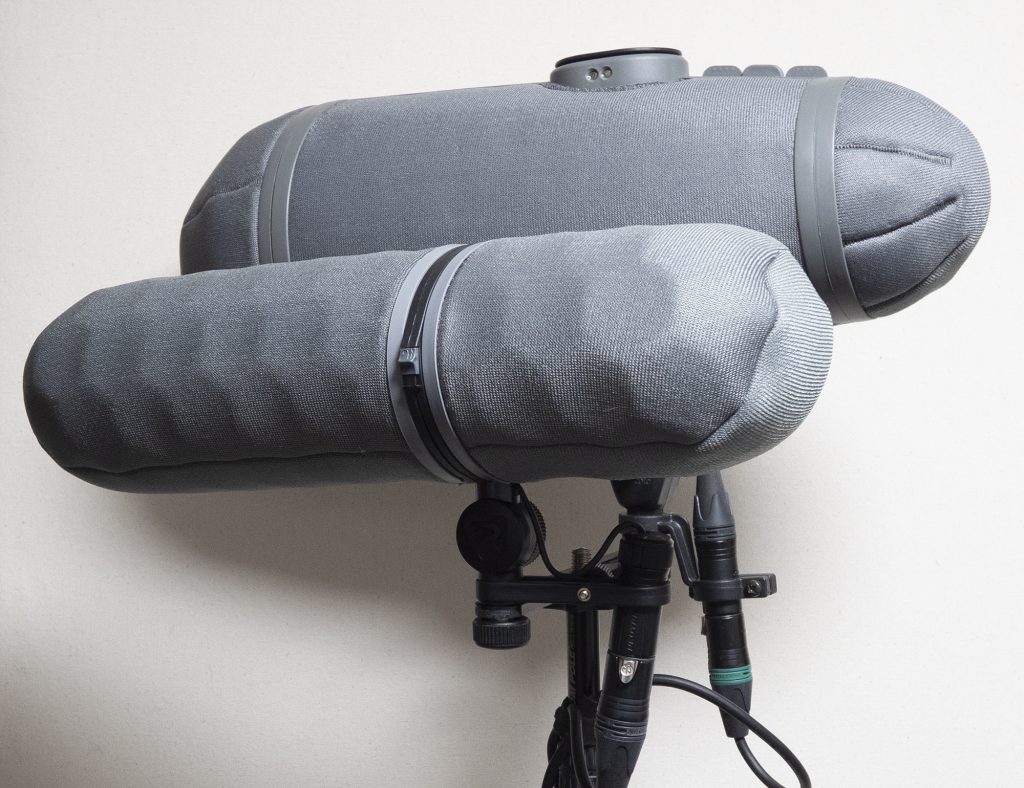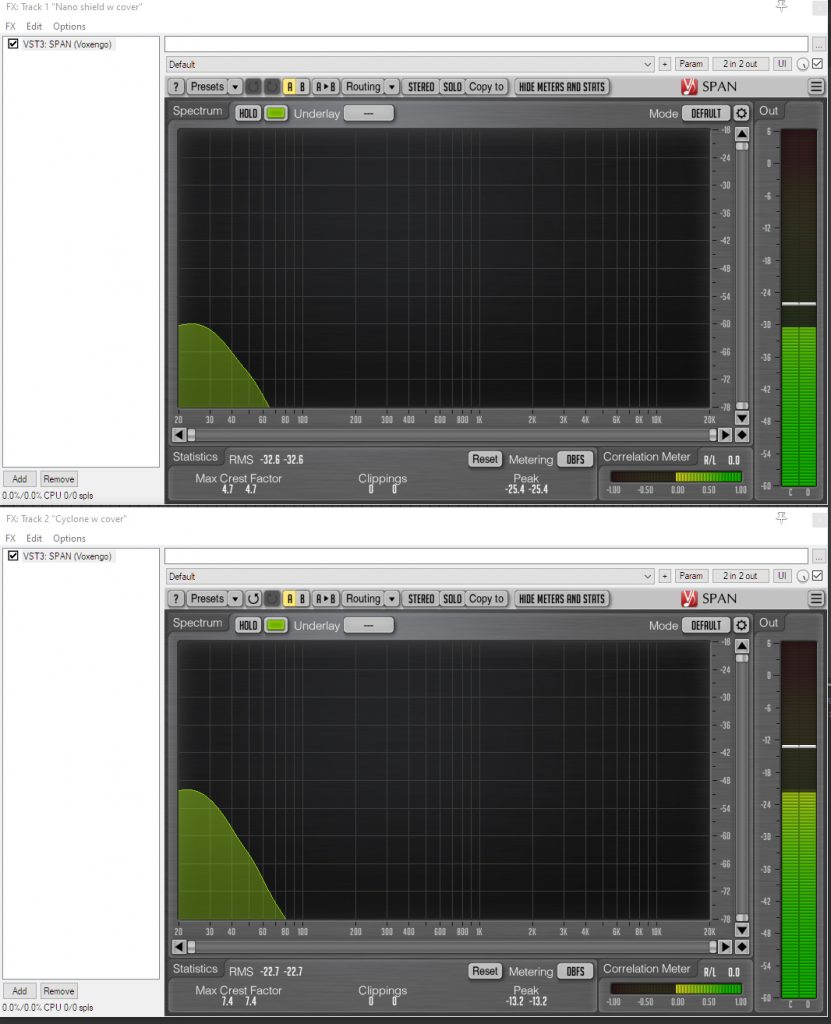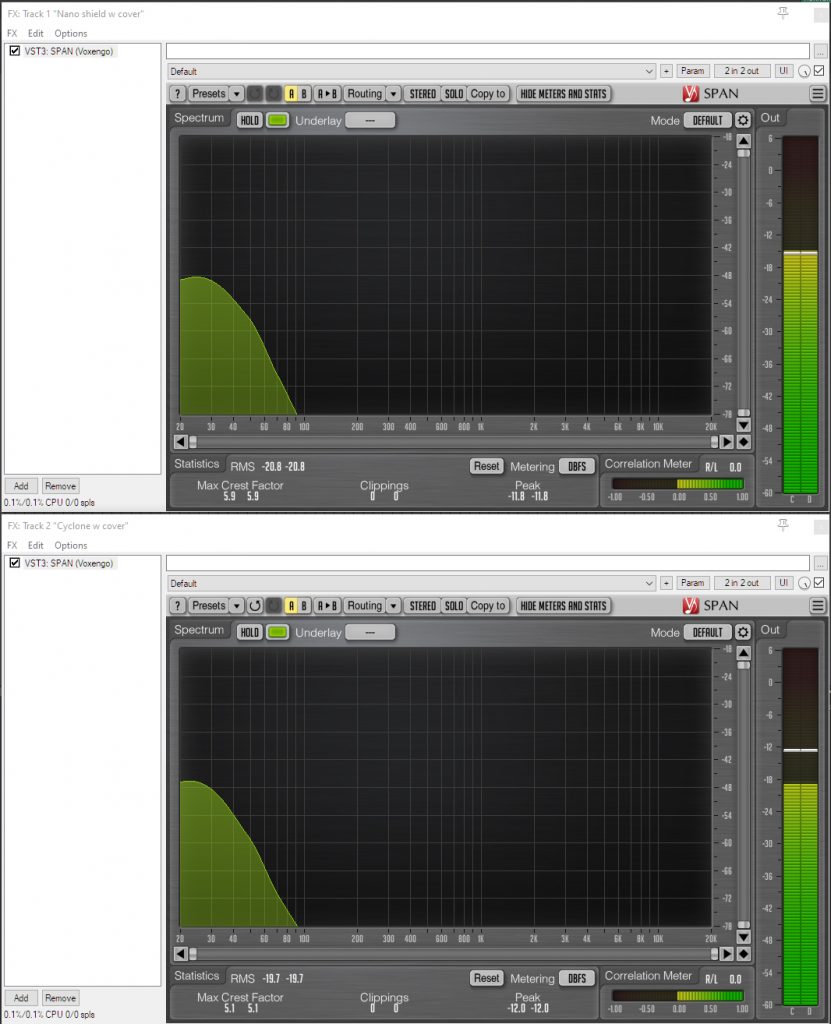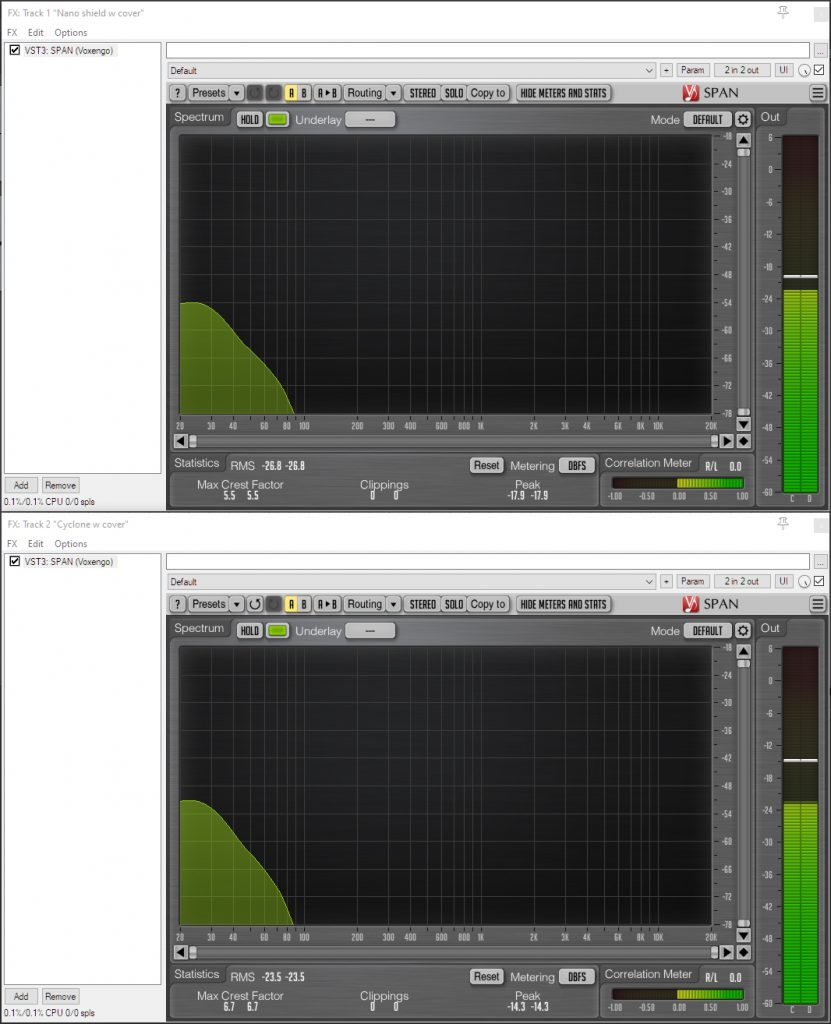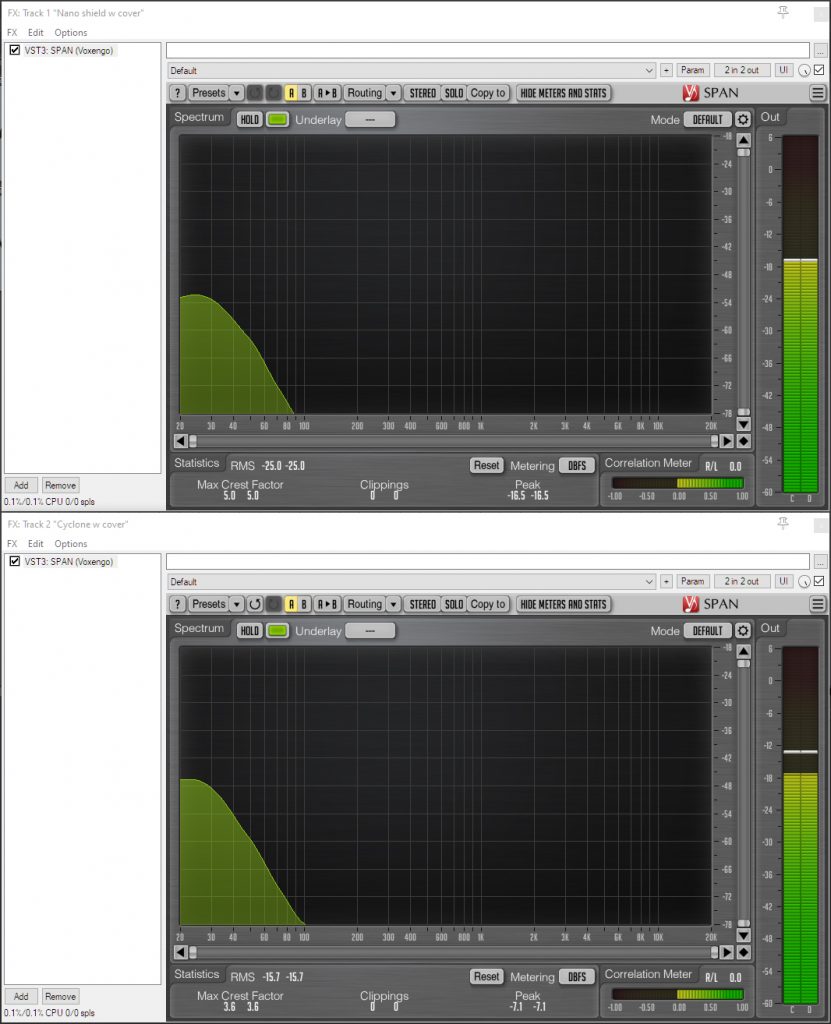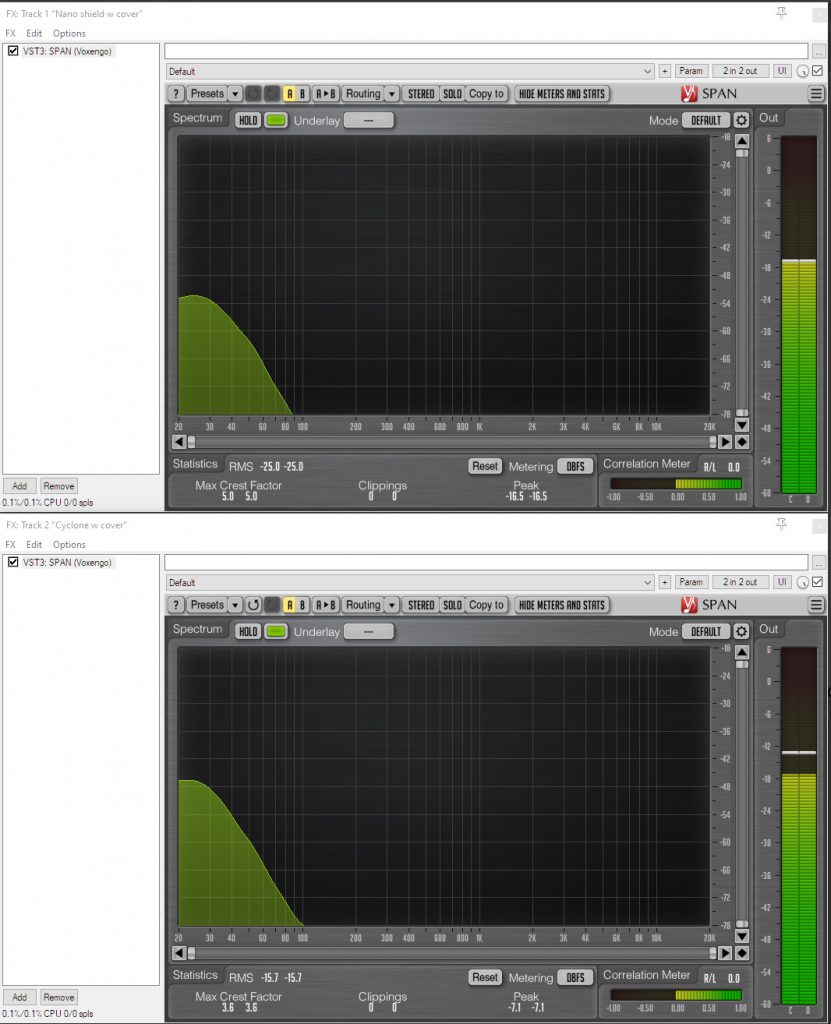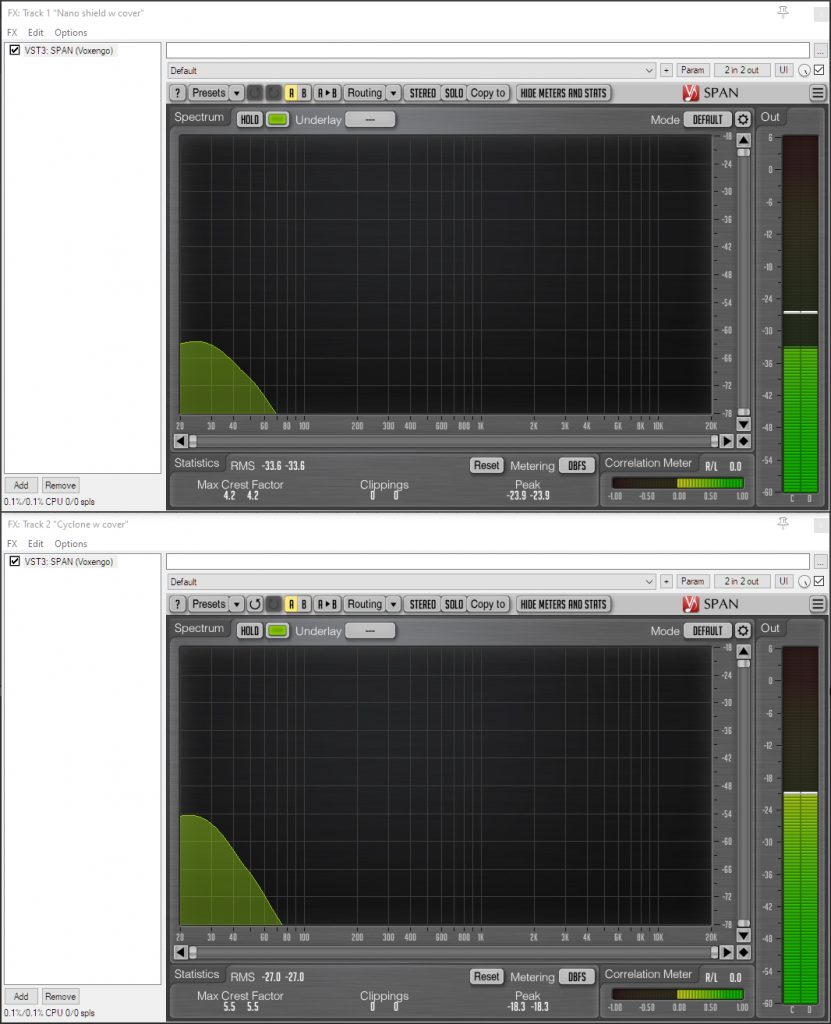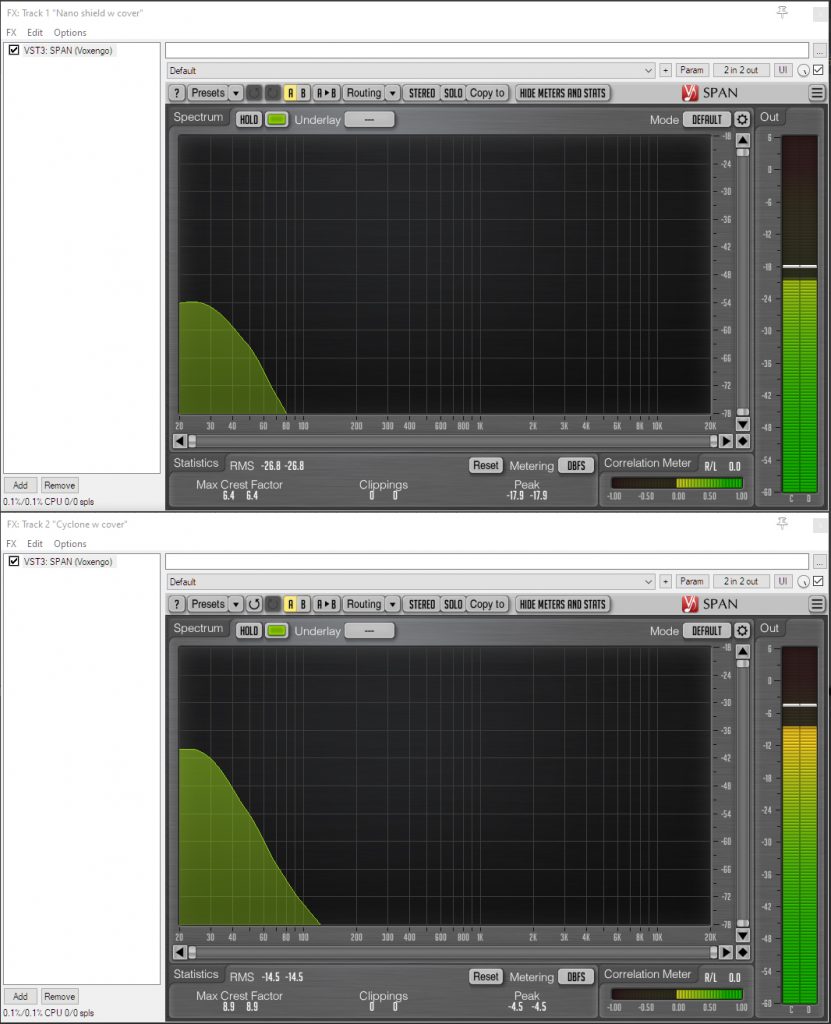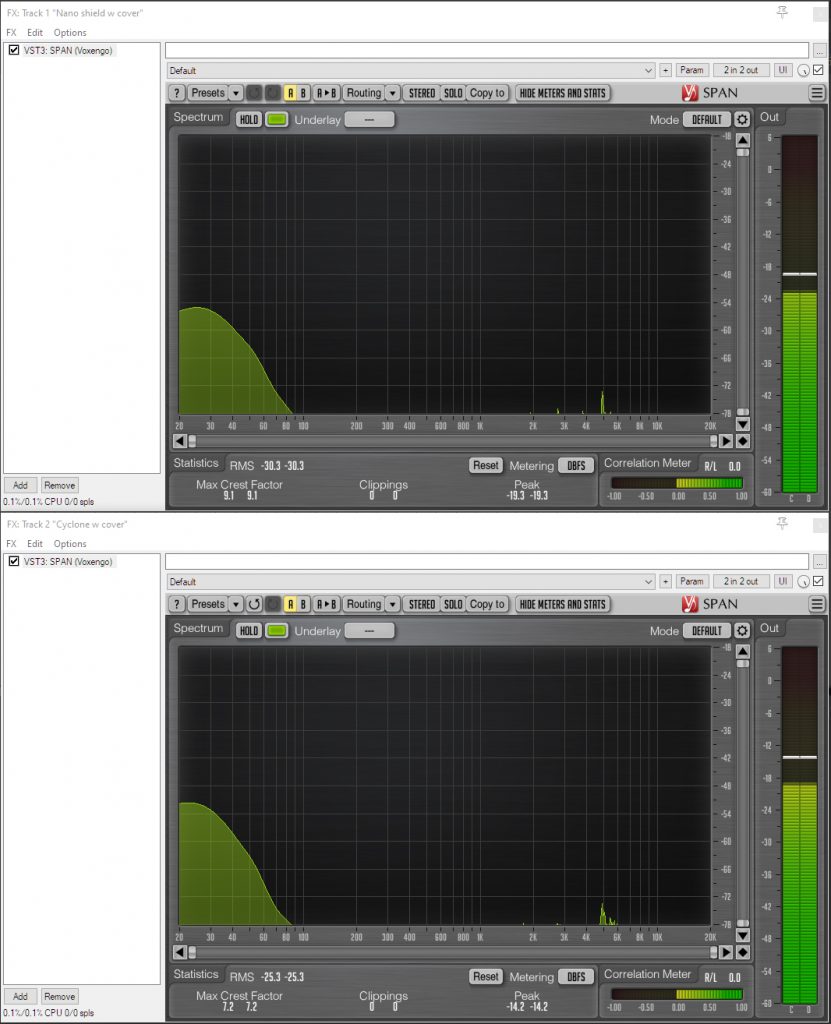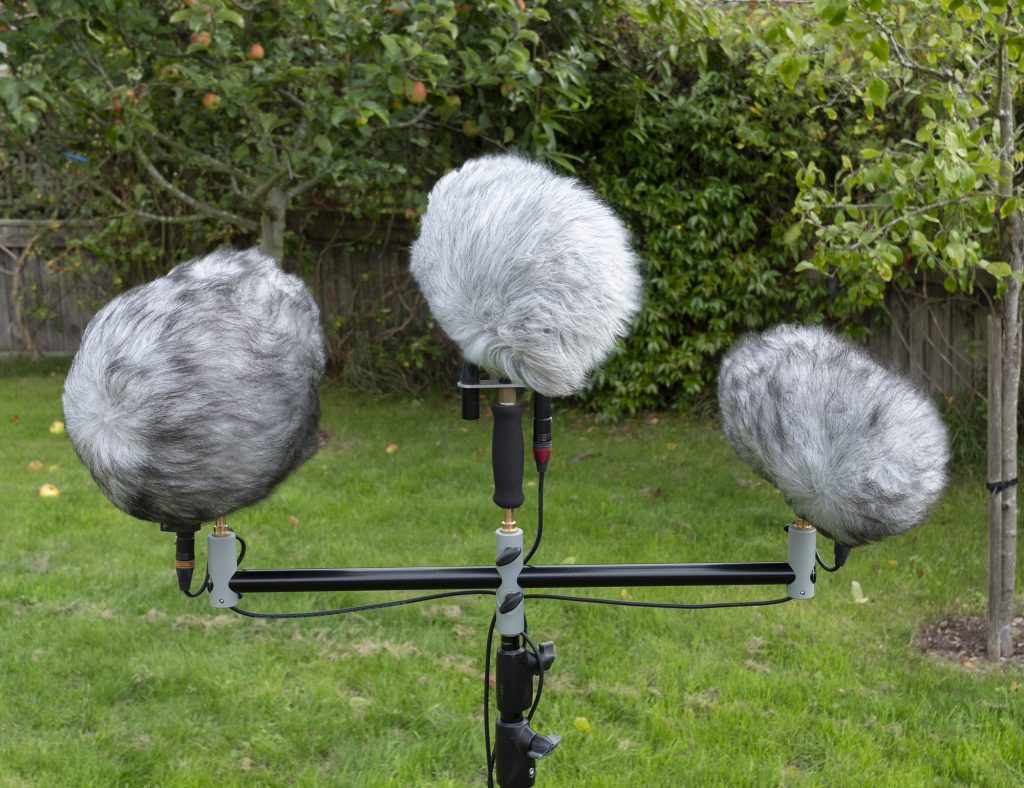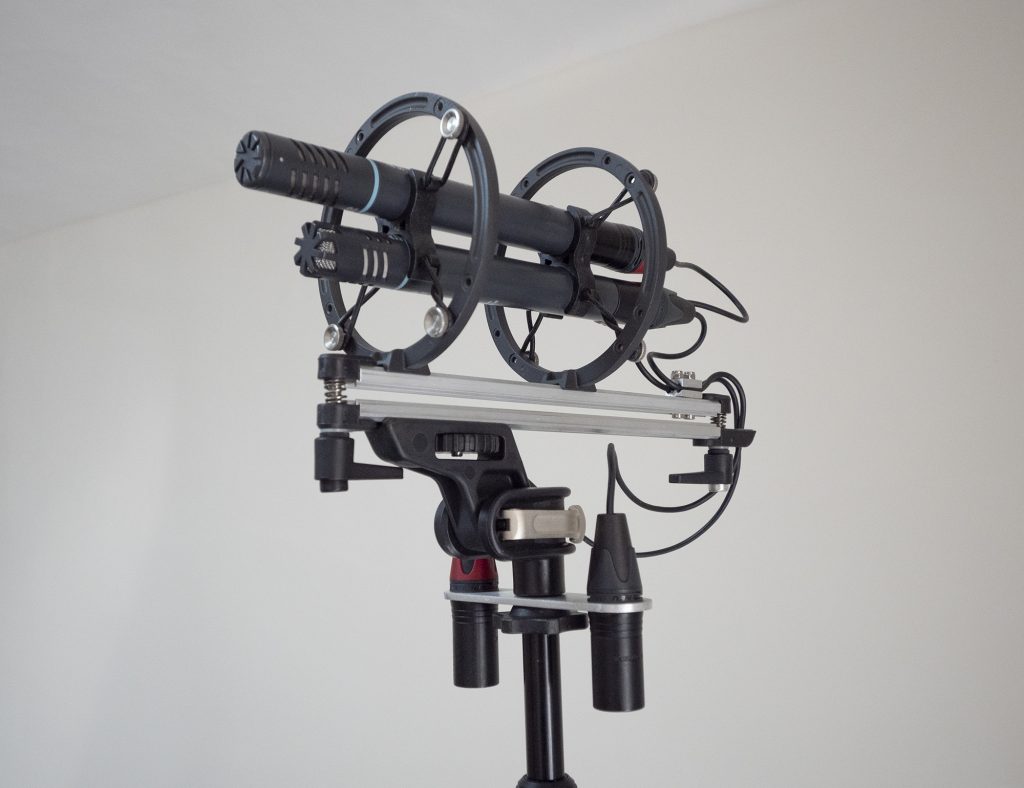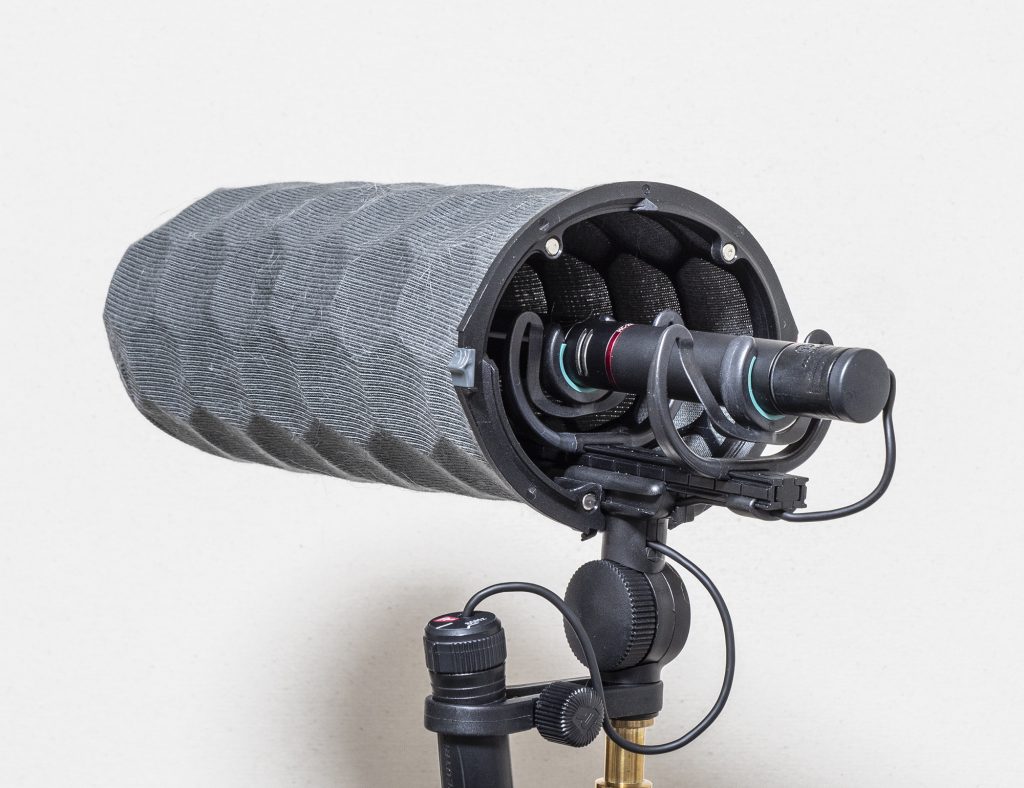
Introduction
One of the beauties of mid-side recording is its suitability for stereo recording outdoors, with the pair of mics fitting into a single windshield. This, and the fact that the fig 8 side mic can be omitted and just the mid mic used, has meant it has become a common tool for production sound recordists who occasionally need a stereo capability. But mid-side rigs are often a good solution for others recording outdoors too: those recording effects, sound libraries, ambiences, nature and, even, music. Over the years I have used a variety of windshields for mid-side recording, including the humble Rode mk 1 blimp (very flexible in terms of different mic combinations), the Rycote Nano Shield (a bit of a squeeze to get two mics inside), and, for LDC mics, my massive DIY blimp. My default windshield for mid-side recording of late, however, has been the Rycote Cyclone: more particularly the Stereo Cyclone Kit 5, which is configured for an MS pair of 19/20mm mics. And there are new compact options on the horizon: Radius Windshields is nearing production of its mini-ALTO and then ALTO windshields, which will have dedicated MS clips as options, and in Sept 2023 Cinela showed its prototype Cosi windshield for the MKH 8030 MS pair, although its production remains uncertain.
For this post I am focusing on three of the most popular options, and ones that are of a sufficient size to promise reasonable performance outdoors in more than a gentle breeze: that is Cinela’s Zephyx and Pianissimo, and Rycote’s Cyclone. I often read on field recording and similar forums how some recordists, not always beginners, consider just how good a small windshield to be, but, while there is a place for compact protection when wind is light, there is no getting away from the physics. If you need a solid introduction to that, I suggest starting with Bleazey, J.C., ‘Experimental Determination of the Effectiveness of Microphone Wind Screens’, Journal of the Audio Engineering Society (Jan 1961, vol. 9, no. 1), 48-54. Indeed, it is worth remembering that the windshields considered here are themselves compromised on the size front so as to be able to be used on a boom-pole or easily deployed in the field. And if you don’t believe me and the engineers, then keep on reading since, by way of an example, further down the post I do include a test of the Pianissimo vs the diminutive Rycote Nano Shield NS1-BA: not least because I have posted previously on my blog showing how you can squeeze an MS pair into the latter, and it is important to understand the limitations of such small rigs.

The Cinela models tested are recently released variations set up for the Sennheiser MKH 8030 + MKH 8000 mics, and have dedicated MZL connections. As I began these tests, Rycote put into production two new MS Cyclones dedicated to the same mics (one with MZL connectors – the Stereo MS Cyclone Kit 17 – and one with XLRs – the Stereo MS Cyclone Kit 18), but I am using the older Cyclone Kit 5: it uses the same small Cyclone basket and I have set it up similarly as the new models in terms of lyre positions. With the tests relating to mid-side recording, the three windshields see a focus on aspects that might not be as relevant to, say, a shotgun mic: erratic off-axis response is typically a feature of such highly directional mics, whereas the sideways looking fig 8 mic of a mid-side pair demands much more transparency from the sides of a windshield and, therefore, this is examined closely here. That said, hopefully many aspects of the tests should be relevant to those thinking of using the Zephyx, Pianissimo and Cyclone for other mic configurations.
Design and construction
Before getting stuck into testing the three windshields, it is perhaps worth writing a few words on their design and build, not least as there isn’t a lot out there on the Cinelas in particular. Obviously, there is little purpose in repeating what is on the manufacturers’ websites, so do go and look at those: rather, I will cover the main points that have interested me from having the windshields in my hands.
Zephyx: The basket’s overall dimensions are a maximum of 175mm W; 257mm L; and 179mm H. The shape is better appreciated in the photos, and we should be grateful to Cinela for leading the way with the non-cylindrical approach. Weightwise, this version is 405g with the fabric cover only and 588g with the fur added. The grey injection-moulded vertical (longitudinal?) and horizontal ribs interlock and are glued, and there are additional small straight struts top and bottom. The basket comprises two parts, with the smaller rear part attached with lugs/clips (and this is easy to attach and remove). Removal of the rear part allows access to the interior, but this access is principally to allow the user to loosen the screw that holds the shock-mount in place: fitting and removing the mics (at least with this MS version) is not really possible unless the shock-mount is removed from the front basket part too. Even after several weeks of use, I didn’t grow to like the screw fitting of the shock-mount to the basket: it is fiddly. The mic shock-mount attaches to the four-armed suspension, which connects to the front (or main) part of the basket: the independent basket suspension was a revolutionary approach when first introduced with Zephyx in 2007. When whole, the basket has plastic rings top and bottom: the top one provides a fixing point for the vertical, or longitudinal, ribs, while the bottom one also houses the round plastic bellows that provide a flexible air seal between the basket and the shock-mount (allowing some independent movement). The ribs have T-shaped sections, 5mm wide and 8mm deep, so are quite chunky (more so than those of the Pianissimo). Although the ribs are doubled where the two parts of the basket join, this is to the rear of the mic capsules and, thus, this suggests that they are not too large an acoustic issue for MS mics: of course, in a basket designed from the outset for MS, this is perhaps to be expected. The version of the Zephyx for the MKH 8030 + MKH 8000 MS has a double-mic clip, top and bottom loaded, with elasticated ties to hold the mics in. Such ties were new to me, but, as long as access is good (i.e. out of the basket), they are easy enough to use and I like the fact that they are gentle on the mic bodies. The two elliptical E-OSIX (hardness grade 00) shock-mount isolators are canted in at the sides, supporting the mic pair at the middle of the MS clip. This is a quite different configuration than for earlier MS options for the Zephyx, and looks to be an improvement. In short, I am impressed by the design of the MS shock-mount from the bar that holds the suspension hoops upwards: I am a little less enamoured with the design and materials of the section below, with the screw fixing to the basket, the conn box (a little homely, but usefully smaller than the Rycote ones), the bellows, the XLR holder and the 3/8″ mount. Not to say that I had any problems with these lower parts, other than the fiddly screw, and that they aren’t all robust enough and effective: just not entirely what I expected on a relatively expensive windshield.



Pianissimo: The basket’s overall maximum dimensions are 165mm W; 324mm L; and 140mm H. Weightwise, this version is 370g with the fabric cover only and 560g with the fur added, so a little lighter than the Zephyx. The grey injection moulding has the look of the sprues or, more correctly, runners, used for the Airfix kits I made as a nipper. It comprises two halves, top and bottom, which separate to allow access to the interior: unlike the Zephyx, you cannot remove the basket from the shock-mount, but that didn’t concern me, and I found it much easier and quicker to access the mics than in its older sibling. The fabric cover for the lower half stays on permanently, while the cover for the top half has to be put on after the two basket halves are joined (it is elasticated and overlaps the lower half of the basket). Although the four-armed suspension connects to the bottom half only, the top half has the same fixing points, which is surprising as the two half-basket mouldings are not entirely identical: the upper one lacks the integral thick ring at the bottom that allows connection to a boom pole or stand. No great significance, but, again, something I wouldn’t expect in a relatively expensive windshield. There are different gauges of plastic in the basket: 3.1-3.4mm diameter round minor ribs and approximate circles; 3.5mm wide x 6.7mm high T-shaped longitudinal ribs top and bottom; and three sets of T-shaped main cross-ribs c.8.0mm wide and 6.7mm high. The last expand into wide round feet, 15mm diameter, which form the push-fit connectors between the two halves of the basket: when joined together, these feet form six cylindrical posts 75mm high. Although the Pianissimo basket has smaller spaces between the basket components than the Zephyx, the lighter structure and placement of the larger elements means that, on visual grounds at least, the design looks to be more transparent. The main concerns from a mid-side recording perspective are the front and middle rings, with their thicker posts at the joins: the front one is positioned off-axis to a forward-facing mic, and the middle one, which is set behind the mic position a little, is positioned off-axis to the side mic. The version of the Pianissimo for the MKH 8030 + MKH 8000 MS has the same back-to-back clip for the mics and suspension as the Zephyx, which is excellent.



Cyclone: The basket’s overall dimensions are 160mm maximum diameter; and 285mm L. Weightwise, this version is 620g with the integrated fabric cover only and 744g with the fur added: so significantly heavier than the Cinela models, with the difference being greatest without the furs (the Rycote fur being lighter). While also being made of grey injection-moulded plastic, there are substantial differences from the Cinelas: the 3D-Tex material is integrated with the basket; the basket is quick to assemble and disassemble (leaving the shock-mount easily accessible) due to its form and connection (held together with magnets and four small levers); and the basket structure is made of smaller cells and ribs of smaller dimensions (3.5mm wide). The smaller cross-section of the ribs of the basket is countered, however, by more substantial mouldings at the top and the bottom (for connection to the shock-mount) and to allow the two halves of the basket to clip together easily, with magnets to aid the fit. As a result of the division of the basket into two parts, the junction of the front semi-dome with the tapering body to the rear is marked with a 19.5mm-wide plastic ring. I can’t pretend other than that this ring has made me wonder about the Cyclone’s suitability for MS as it is positioned on-axis to where naturally you would have the sideways-looking fig 8 mic: with that in mind, I have been using the Cyclone Stereo Kit 5 with the mics forward of this plastic ring, and I notice that is exactly how Rycote have set up their new MKH 8000-specific MS versions (the Stereo MS Cyclone Kits 17 and 18). Obviously the ring remains within the lobes of the fig 8 and the mics are now pushed rather further into the front cap than is ideal (I remember the advice of the designer of the original Cyclone, Chris Woolf, that this was to be avoided…). The basket suspension for the Cyclone is a lot more substantial than that for the Cinelas, which again adds unwanted bulk (and weight), albeit in arguably less sensitive locations than the basket ring: both the top and bottom parts house multiple lyre-like suspension elements to provide a flexible connection to the basket, and are joined by the removable C-arm. The latter itself provides an extra component within the basket, but it is set well behind the capsules of the MS pair so is unlikely to cause significant acoustic issues (DMS may be another matter: one for a later test). More positively, the Cyclone offers a lot more immediate flexibility than its Cinela counterparts: you can move the lyres, reverse them and, indeed, even replace them with Radius hoops should you wish, while the Cinelas very much come specific to the MKH 8030 MS pair, although additional suspensions for different mic set ups can be bought (at a significant cost).


Overall, then, there is no doubt that the Rycote Cyclone is more flexible, makes use of more consistent materials, and seems better built and better engineered. But, and this is a big but, this engineering gives it some large and chunky components in the thick mouldings in parts of the basket (from an MS perspective, most concerningly the wide ring at the rear of the front cap) and the top, bottom and C-arm of the shock-mount/suspension.
Operation
The two Cinelas operate quite differently. As we have seen, while the Zephyx allows the shock-mount to be used without the windshield, the Pianissimo does not. The Zephyx, then, is like the Cyclone (where the basket and, if required, the C-arm can be removed), although the process of removing and adding the Zephyx’s basket is much more fiddly. For some, this ability to remove the basket may well be crucial: for example, if transitioning from outside to inside booming. That said, such a transition with a mid-side pair may be less common than with a single more directional mic. Certainly, having long used a Cyclone I have rarely found myself using it sans basket as a shock-mount: rather, I have found the ability to remove the basket primarily of use in installing and removing the mics, unimpeded. The ease with which the Cyclone basket can be removed and replaced is very different than with the Zephyx, which is rather more fiddly – it requires removal of the back part of the basket and unscrewing the knob below the mic suspension, with replacement being fiddlier still, getting the bellows in place and getting the screw into the hole. Far from ideal in the field, let alone in low light. So from a practical point of view, the apparent limitation of the Pianissimo of not being able to use sans basket is far from that: while still short of the slickness of a Cyclone, removal of the top half of the basket to get access to the mics is much easier than with the Zephyx.
Obviously the integration of the fabric cover of the Cyclone with the basket means that there is no additional process involved on that front, while both Cinelas need their fabric layer adding after the baskets are assembled. This is a little fiddly, but not as difficult as putting on their fur covers: both furs are unlined, quite stiff and with a coarse internal surface, so are much harder to fit than the lined Rycote fur. Indeed, all the Cinela preparation operations are much easier to do with the windshield in your lap than, say, on a stand at head level (if, for example, doing field recording): I have found myself pulling on a Zephyx fur with both hands providing counter-resistance to the considerable tugging by use of my forehead against the rear of the windshield. Fortunately, nobody has witnessed my clumsiness, and doubtless those using the windshields day-in day-out have mastered the techniques.
When it comes to mounting the windshields, there are differences again . The two Cinelas have XLRs close to the attachment point, evidently geared to boom-pole use, but with no flexibility in positioning, while the Cyclone allows rotation of the whole pivot clamp (indeed, swapping between a 3/8″ and quick-release versions) and the XLR, which is very useful for field recording set ups. Small details that may not matter to some. And this isn’t to argue that for my usage the external details of the Cyclone are entirely preferable: for instance, I have found the small pivot clutch of the Pianissimo easily the best of the three windshields, gripping well without recourse to an over-sized lever like the Cyclone.
Finally, there is the operational aspect of cueing. The Zephyx is harder to point in the right direction than the other two windshields, largely due to its more spherical shape, but also due to how the mics sit inside the basket.
So, operationally, although some have eulogized the Cinelas on all fronts, there is no doubt in my mind over a period of using the three interchangeably over six weeks, that the Cyclone is much easier to set up, add/remove the basket, and dress/undress with its fur. It is followed at a distance by the Pianissimo, and with the Zephyx very much in third place. Once ready to use, the Cyclone and Pianissimo are much easier to aim, with the Pianissimo slightly winning on this front and certainly so in terms of weight when on a long boom pole; the Zephyx is less easy to aim, which doesn’t only matter for production sound, but also for field recording – not problematically so for the latter use, just needs a little more care.
So the question you might be asking – and I certainly was having first set up the Cinelas – is the much-heralded performance of the Zephyx and Pianissimo evident and enough to outweigh any downsides? Well, high time for some testing then!
Handling noise
All three windshields have sought to tackle vibration by having baskets that have separate suspensions from the microphone shock-mounts. As we have seen, Cinela was the first to introduce this with the Zephyx in 2007, and it was then adopted in the Pianissimo (introduced in 2014, after the similarly styled, but longer, Piano model of 2012). Rycote introduced its version of independent basket suspension with the Cyclone in 2014. To compare the windshields I mounted two at a time on a stereo bar at the end of a boom pole and carried out both a static test (i.e. holding the extended boom steady so all that was transmitted was my muscles straining – not insignificant given the weight of two such windshields and my lack of muscle!) and a deliberately shaking/vibrating test. Given the similarity of the two Cinela mic and basket suspensions I found the difference in handling noise to be negligible, but they are both observably different from the Cyclone. Testing the static hold first, here are the sound file clips:
While rendering the clips I noticed that the LUFS for the Cyclone recording was slightly lower (1dB), but listening to the files it is clear that the additional energy in the Pianissimo recording is at a lower frequency and, consequently, to human ears it sounds much more effective. You can see this different frequency in the spectrum analyzer visualizations, with the vibrations falling away very quickly from around 50Hz in the Pianissimo compared to the Cyclone:

Moving on to the tests with the pair of windshields on the end of the boom-pole being deliberately shaken, here are the sound files:
Again, the Cyclone produces slightly less noise in the test (this time by 2dB when considering LUFs and with a peak 3.8dB lower), yet the frequency spectrum of the noise makes it more audible, as the spectrum analyzer visualizations confirm:

While the differences in the suspensions between the two Cinelas and the Cyclone are measurable and audible, it is hard to tell whether this will be relevant to any user: it will come down to a matter of how much movement is likely, be that fast boom swings (which seem unlikely with an MS pair), handling noise or, if stand mounted, transmitted structure-borne noise from the ground or the stand (the latter itself perhaps produced by wind buffeting), and the degree to which use of an HPF (and at what frequency) is acceptable. In practice, I have not found the Cyclone any less usable on shock-mount/suspension grounds than the Cinelas, but it is something to bear in mind: there is a difference and it may well matter to some users. Certainly it is likely to matter to production sound recordists using versions of the baskets (very probably not the MS variations considered here) on boom-poles.
One interesting aside on suspensions and handling noise is the question of reduction in the mass of the MKH 8000 mics by use of the MZL connectors. MZLs are great when you want to reduce the visual impact of the already small mics (say while recording a live or filmed performance) or where reduction of the bulk of the mic helps acoustically (most obviously in double mid-side – or DMS – recording), but it isn’t entirely clear to me why it is so advantageous for an MS pair in a large windshield, where the additional mass of the MZX 8000 XLR modules and then the XLR plugs themselves may well help lower the resonant frequency of the spring system of the shock-mount (something that Chris Woolf discusses in his eminently readable article ‘Keeping Microphones Quiet’in LineUp 120 for summer 2009, which is freely available via the IPS website). Indeed, when including the pair of MZF 8000 ii filters when he sent the Cinelas, Philippe Chenevez made the point that this was because ‘the suspension is optimised for those, whatever [sic] you switch the filter on or off’: in other words, the additional mass seems to be helpful (although, of course, in addition to its switchable 70Hz HPF, the MZF 8000 ii has a fixed low-cut filter at 16 Hz). More prosaically, the additional length from the MZF filters helps with fitting the mics, but then so would the MZX 8000 XLR modules and, of course, if XLR connectors were used then other similarly-sized mics could be used interchangeably. That’s certainly the case with the Cyclone model used for these tests, which I use equally happily with the Rycote range of mics.
Transparency
I really began to think about transparency of windshields when finally getting around to comparing the wind reduction performance of my massive DIY blimp (built for LDC mics many years ago) to that of my smaller windshields: I had never tested the DIY blimp with SDCs before. As expected the reduction in wind noise was considerable, which is the inevitable consequence of its large size, but I was surprised by how much more transparent it was: I could hear much more in the way of leaves rustling and birds tweeting. What was unclear was how much this was to do with differences in size, coverings, basket design/construction, and shock-mount and other internal differences. Of course, some attenuation of higher frequencies is to be expected from a windshield covering, especially fur – that’s the quid pro quo for wind noise reduction – but, evidently, additional colouration should be minimized: this seems especially relevant to mid-side stereo pairs in a windshield. So a considerable amount of my time testing these windshields was focused on transparency, comparing, where possible, the impact of the bare shock-mount, then the bare basket, the basket with any fabric added (or permanently fixed to the basket), and the impact of adding fur. The tests were carried out using an MKH 8040 cardioid and MKH 8030 fig 8 pair rather than a calibrated test mic: this was due to the shock-mounts (and for the Cinela windshields, the connectors) being designed for such mics, and because I wanted to test the windshields with the actual mics that would be used and in the exact positions in which they would be placed.
In the absence of an anechoic chamber, I started off by making quasi-anechoic measurements, in which room reflections are removed by adding a gate, or time-window, which in this case was 5ms. This meant that lower frequencies were not measured, but this wasn’t a significant concern as my preliminary rough tests showed that colouration only became significant – and significantly different – at higher frequencies. To allow repeatability as I swapped windshields, added baskets to shock-mounts etc. I took a leaf from the Dambusters: instead of using convergence of angled lights to show an exact distance (in that case 60ft above the reservoirs) I applied Benjamin Lockspeiser’s inspired idea to angle two laser levels to coincide on the centre of the mic capsules, allowing me to set and reset distance and height to millimetre accuracy. By angling the two laser levels on axis to the loudspeaker and at 30 degrees, alignment of the mic bodies was also made easy: to reduce the number of measurements to something manageable I had decided to measure head-on (0 degrees) and at 30 degrees with the forward-facing MKH 8040, and at 60 degrees and 90 degrees with the sideward-facing fig 8 mic. Not the full 360 degrees of a polar plot, but, of course, with a full frequency sweep from 200Hz to 20kHz. Simplifying things by reducing the number of angles was just as well as it still took me 11 hours to work through the measurements, each time leaving the test room to control things (via REW software) from my PC: maintaining stability of the windshields while progressively adding baskets, fabric and fur took immense patience and, in some cases, multiple attempts. I am only too aware that much better and more comprehensive measurements could be achieved with an anechoic chamber, better equipment and more expertise, but this is at least an attempt to carry out measurements and I am happy enough with the broad gist of the results.

I began the series of measurements looking at the impact of shock-mounts alone. This was measurable with the Cyclone and Zephyx, as only they can be removed from the basket. There was a modest, albeit quite noticeable, impact at 0 degrees vs the bare mics in a back-to-back clip mounted in the simple mic clip provided by Sennheiser, becoming more significant at 30, 60 and 90 degrees with the Cyclone, probably due to the large plastic C-arm (left in place for this test) that links to the top of the basket. Moving on to the impact of bare baskets, this was measurable with the Zephyx and Pianissimo only, as the Cyclone 3D-Tex fabric is bonded to its basket. This showed reasonably increased colouration over shock-mounts only, most noticeable at 30 and 60 degrees with the Zephyx, which makes sense when you consider the more substantial impact of the basket ribs (which are much larger in cross-section than those of the Pianissimo) at such angles. As a comparison, I measured the impact of my massive DIY blimp basket, which was negligible in comparison, as would be anticipated given its open structure and the thin structural components (3mm diameter stainless-steel wire). However, windshields need a covering to be useful, so, though the shock-mount and basket components will have an acoustic effect, sometimes considerably so, it makes sense to look in more detail at the measurements with coverings on.



With a straight-on signal to the front of the windshields the performance of the three baskets with the addition of the various fabrics supplied shows a fairly modest colouration of the sound, broadly consistent across the different models, with very little attenuation. The addition of the fur shows, as expected, a significant attenuation in high frequencies, beginning as low as 1kHz. The Cyclone and Zephyx are close in this test, with the Pianissimo performing less well, especially from around 12kHz where the attenuation increases significantly. I found almost identical results when repeating the test, but swapping the long-pile fur for the short-pile fur also supplied. Thinking more generally about the attenuation from fur, below is a graph showing the same test but with my massive DIY blimp, in which lined fur (both lining and fur supplied by Rycote many years ago) sit directly on a more open basket, which itself has no fabric covering. In this case, the impact of the fur is much reduced, and there is very little attenuation of high frequencies: food for thought.

Anyway, back to the three windshields we are primarily concerned with here! Turning to their transparency at 90 degrees is particularly relevant to their MS use, as this is, of course, on axis to the fig 8 side mic.



Not unexpectedly, when the sound is measured from the side of the windshield, the Cyclone is showing significant colouration from around 7kHz, with a series of peaks and troughs from around 9kHz: that these are seen in the basket + fabric measurements as well as with the fur on confirms that they relate to the basket design, with the obvious culprit being the large plastic ring around the windshield that joins the cap to the tapered body. I understand from Rycote that the suggested set up for the new MS Cyclones for the MKH 8000 mics, whereby the mics are pushed forward into the end-cap, is a consequence of measurements of the impact of this plastic ring in the anechoic chamber: my crude measurements previously with pink noise suggested the same, and, as I mentioned previously, I have followed Rycote’s proposed more forward positioning. The Zephyx sees some similar, but much reduced, behaviour to the Cyclone from around 9kHz too, affecting basket + fabric and fur, while the Pianissimo sees little attenuation with the basket + fabric at any frequency and, in a sharp reversal of its performance at 0 degrees, some fairly modest attenuation when the fur is added.
With no published data for windshields (if only we could have detailed polar plots and frequency response graphs with, say, a measurement omni mic for each windshield basket design), I found making my measurements (necessarily many more than included here) an instructive if painfully long process. It confirmed my suspicion that none of the windshields was free of colouration, suggested that the Cyclone held its own with forward-facing mics, but that the Cinelas had better all-round transparency, and, above all, that they did not suffer from anything equivalent to the impact of the Cyclone’s wide plastic ring on the fig 8 mic. Again, as with the difference in handling noise, whether or not the different transparency matters is another thing: given these tests and what I have noticed with a more informed ear as I listed to my MS field recordings, I would be less inclined to use a Cyclone with an MS rig for the most demanding situations (say outdoor acoustic music recordings), but for many a field or sound effects recording, I suspect that the colouration would be too subtle to notice. Anyway, after all this measuring, with relief, I packed away the laser levels, restored furniture to the test room, turned off the PC, and headed outside…

Wind reduction
While much of this post has been about the compromises that windshields bring – the fiddliness and faff, the inevitable effect on the sound recorded – the bottom line is, of course, the ability to reduce the impact of wind noise on the microphones, whilst keeping these downsides to an acceptable minimum. After weeks of a strange anticyclonic gloom in October and November, at last the weather changed so I headed up to the coast at Cley to get a bit more wind to compare the difference between the two Cinela models. Pointing them into the northerly onshore wind, I first tested the Cinelas with just their fabric covers on (these being a double layer polyester/polyamide fabric), and here the Zephyx clearly won out by a substantial margin, presumably reflecting its larger size and more spherical shape (the latter better for turbulent wind):
Putting furs on made a huge difference, as expected, but interestingly the difference between the two models is much reduced, although the Zephyx still performed better in terms of wind reduction. And in neither test is there an obvious difference between the two windshield models in the recording of the footsteps walking past on the shingle, which were included to get some sense of the effect of the wind reduction on higher frequencies. Admittedly, this isn’t as nuanced as recording an acoustic instrument or vocal, but in the real world these are unlikely to be recorded on an exposed windy shingle beach.
With the strong sound of the wind and the sea beyond, and the fact that the incoming spray wasn’t doing my specs or the equipment any favours, I thought perhaps something more subtle might be equally, or more revealing, so beat a retreat to the garden. There, in addition to wind, there was the noise of leaves moving, the singing of the odd bird that forgot to migrate somewhere nicer for winter, and other village street noises. Again I kicked off with the Zephyx with just its fabric cover, but this time compared it to the Cyclone also without its fur:
The difference between the two windshields is very obvious, with the Cyclone picking up so much more wind noise. Of course, the construction is quite different – the Zephyx having its fabric ‘Z-cover’ stretched over the basket, while the Cyclone has its 3D-Tex material built-in to the basket, with plastic elements of the latter remaining exposed.
Adding furs reduced the wind noise, of course, but the difference between the two windshields remains very evident.

With Storm Bert hitting the UK, scope for windier tests improved, so I went through a whole sequence of comparisons with the MS pairs, each time comparing the Pianissimo to another windshield. First is a variant of the last clips, albeit with more wind, being the Pianissimo (with its long-pile fur) vs the Cyclone (with its fur, of course):
And here are the spectrum analyzer visualizations of the difference between the two, with the audible component (say above 20Hz) clearly greater with the Cyclone.

As we saw (or heard) with the Zephyx vs Cyclone comparison above, the difference between the two windshields is substantial again, with the Pianissimo offering much better wind reduction that the Stereo Cyclone.
With the gusty wind, I thought it would be interesting to repeat the Pianissimo vs the Zephyx test, this time without the background white noise of the sea. First up is the Pianissimo:
And here is the recording of the Zephyx:
The differences between the two are perhaps rather more evident than in my tests on the beach, and, clearly, of the two Cinelas the Zephyx does a better job at reducing wind (entirely as expected and as advertised, I should hasten to add!). Again, we can see the differences in the spectrum analyzer visualizations:


A slightly unexpected extra in the package from Cinela was a Kelly rain cover for the Pianissimo. I must confess that it will take more than a cheerfully named rain cover to make me think I am Gene Kelly and feel like singing or, rather, recording in the rain – I am a fair-weather recordist – but for some dealing with rain is unavoidable: a few hardy souls even choose to record in the rain. Comprehensive testing of the Kelly is rather outside the scope of my recording experience, but, with the rain cover in hand, I thought that a wind test might prove useful (it is a choice between the Kelly and the fur: you can’t have both on the windshield at the same time). Now, this comparison is between the Pianissimo with the Kelly and the Zephyx with fur: not quite like-for-like, but the two windshields are similar enough and the differences so dramatic that the test is perhaps worth including here:

Obviously, the rain cover is not something you would deploy unless absolutely necessary. And, of course, it’s function is for rain not wind although, of course, wind and rain often go together (certainly here in the UK!). As the Cinela website says: ‘Depending on the strength of the wind and the intensity of the rain, you have to make the best choice between adding the fur or the rain cover. Your experience and your ears will guide your choice!’ Indeed.

Right, and here for something different in the last of this particular batch of tests is a comparison of the Pianissimo with the Rycote Nano Shield, which I promised at the beginning of the this blog post:
As expected, there is a lot more wind noise in the diminutive Nano Shield NS1-BA when coping with the lively wind, and it runs up into much higher frequencies than you’d want (i.e. hard to remove without a high-pass filter set horribly high for most uses – say 200Hz or higher), as evident in the spectrum analyzer visualizations:

While using the Cinela windshields over many weeks I got better at putting the furs on and taking them off (and I guess they would get more supple with use), but still I wasn’t keen on the fiddly process, and began to wonder just how different they would be with a lined fur. Radius Windshields make aftermarket furs for other makes of windshield, such as Rycote and Cinelas, so I tried a pair of these (thanks to Simon Davies). As expected, fitting was so much easier with more suppleness and the lining making the furs slide on smoothly, but what about performance? Testing was a bit difficult, what with having one of each model only, but trying different combinations of furs (including, as controls, both windshields with the original furs and both with the Radius alternatives), it became clear that while so much easier to deploy, the Radius furs (which are very much the same as Rycote ones: not surprising given their pedigree) offered no performance gain, and, if anything, the original Cinela furs (or at least the long-pile variants) have a slight edge.

Anyway, you can judge for yourself in these test files, for which, for a change, I have uploaded the MKH8030 fig 8 tracks only. First off, here are two ‘control’ recordings, with both the Zephyx and the Pianissimo wearing their Cinela furs:
As per the previous tests, the Zephyx has a slight edge in terms of wind reduction. And here are the recordings with the Pianissimo sporting the Cinela (long-pile) fur and the Zephyx with the Radius fur:
There’s not a huge amount in it, and the differences may well be much reduced (or disappear) if using a high-pass filter (you can download the files and have a play in your DAW to examine the effect of your likely HPF settings), but if trying to squeeze every last drop of performance out of the windshields, then the Cinela furs appear to have the edge. But if you are continuously taking the Cinela furs on and off, it is perhaps useful to know that there are some competent alternatives that would make life easier.
And as something of a total aside (I’ve accepted that this is going to be a very long post anyway!), if you are unfamiliar with the physics that relates size of windshield to effectiveness, the Radius furs gave me a chance to make a direct comparison with my large DIY blimp. First off is the Pianissimo with the Radius fur:
And here is the DIY blimp with pretty much identical fur (it has fur and lining provided some years ago by Simon Davies, when running Rycote and, not surprisingly, it seems pretty much identical to the Radius furs):

The differences are significant and, with some background voices of passing walkers, you can also hear the increased transparency of the DIY blimp in the field. Of course, this doesn’t help you if you wish to boom an MS pair or, indeed, travel very light for field of effects recording!
NB In all these wind tests do note that I used no high-pass filtering at all either in the field or in post, so do download the files and play around. My main aim was to show the differences between the three windshields without the masking effect of HPFs being applied. If you are really keen, you can decode back to M and S if, for example, you wanted to hear the difference just on the forward-facing mid mic to compare the windshields for non-MS use.
Pricing
I haven’t mentioned pricing at all so far, other than oblique references to the windshields being expensive. All three are not cheap, which is, perhaps, which is often a bit of a surprise to some: I think this stems from the plastic construction, which lends itself to mass-production, and that the designs of the baskets and main components are not new (so you might hope that the R&D and tooling investment for the injection-mouldings would be offset by now). Anyway, all three cost no more than one of the MS mics inside!
Here in the UK, the Rycote price is easiest to establish: looking at the prices at Pinknoise (and I would use them for any such purchase), the Stereo Cyclone Kit 5 is priced at £758.40 (inc. VAT). The two recently announced versions specifically for the MKH 8030 + MKH 8000 MS are pricier, with the one with MZL connectors – the Stereo MS Cyclone Kit 17 – naturally being more expensive (at £888 inc. VAT) than the one with XLRs – the Stereo MS Cyclone Kit 18 – at £834 inc. VAT (both prices at Pinknoise again). None of these comes with the small Cyclone fur, which you will almost certainly need: this costs another £138 inc. VAT.
It is harder in the UK to establish the price of the Cinelas, since I can find no stockist of these specific models. I am sure that Pinknoise, Soundkit or similar specialist retailers who sell other Cinela models could order either, but I have found prices for both at Audiosense in Brussels, where the Pianissimo (the Cinela Piani-2-8030-8040) is €1,171 inc. VAT and the Zephyx (the Cinela Z-8030-8040-MS) is €1,411 inc. VAT. At today’s exchange rates, these equate to £977 and £1,177 respectively, which are pretty much as I would expect from the prices of other MS versions of the Pianissimo and the Zephyx that are stocked in the UK. Given that both Cinelas come with furs and travel cases, I can’t really see the price would be a determining factor in making a choice between the three.

Conclusions
So where does this leave me or anyone else so minded? Cinela windshields have an excellent reputation amongst professional sound recordists, especially those involved in production sound. Often they are described as the best available and a definite step up from the more prevalent Rycote models, but, in the absence of much comparative testing, it was hard to know what to make of the largely anecdotal evidence. Having had the Pianissimo and Zephyx in my hands for over six weeks, the short answer is that I am impressed, and there is no doubt that they have a significant edge over the Cyclone in terms of pure performance as windshields, not least – as this was the underlying aim of the tests – ones suited to a mid-side pair. That said, I have been a little surprised with some aspects of their construction and the elements of the designs that make them fiddly to use (most especially the means of disassembling and reassembling when changing mics: this is especially the case with the Zephyx), and which are so much better addressed in the Rycote Cyclone.
The design of the windshields has meant there are inevitable compromises in all three cases, some of which they have in common (e.g. overall size). And it is clear that there could be a still better solution within the general design parameters: that is, a windshield as light as the Pianissimo and as effective at reducing wind noise and handling noise as either Cinela, but with a bit more transparency than either of them and, above all, with more of the operational convenience of a Cyclone. But dreaming of non-existent products aside, if I was booming a shotgun mic or a supercardioid mic on a long boom-pole and not continually swapping in and out mics, there is no doubt I would choose the Pianissimo, on grounds of weight, ability to aim and its excellent handling and wind-noise reduction. If you want an MS rig on a long boom-pole, then this is the way to go too. But that isn’t my usage of MS: typically, I am using MS in the field for effects recording with mics on a stand, and frequently swapping out mid mics (changing from omni, to wide-cardioid, to cardioid and supercardioid) and the whole MS pair, and putting the fur on and taking it off again depending on the wind level. And then I am recording music outside, where the lack of complete transparency of any of the options becomes perhaps more evident, but especially with the Cyclone. So I am left scratching my head. Should a sound recordist in similar shoes accept the lesser high-wind reduction of the Cyclone (which, I should clarify, is not at all shabby anyway: it outperforms my other windshields) and the acoustic effect of its large plastic hoop on the fig 8 mic as compromises worth making for increased ease of use in the field? Or should the recordist go for one of the Cinelas, with greater transparency overall and better handling and wind-noise reduction, and just accept it will be less easy to rig? OK, as we have seen, this could be made a bit easier by recourse to an aftermarket lined fur from Radius Windshields, but at the cost of a slight loss in wind reduction performance. And if a recordist is to choose a Cinela, should they go for a Zephyx with its better performance in wind, or the Pianissimo with its greater convenience and ease of aiming? A bit of a dilemma for the recordist that I cannot resolve: what I hope, rather, is to have provided some useful comparative information and food for thought for those looking for capable MS windshield solutions and weighing up these three options. Personally, I would be rather pleased if the Pianissimo didn’t have to disappear back to Paris!
NB Just for transparency, the Cyclone model tested here is one I have been given previously by Rycote for testing, while the Pianissimo and Zephyx have been loaned by Cinela.

